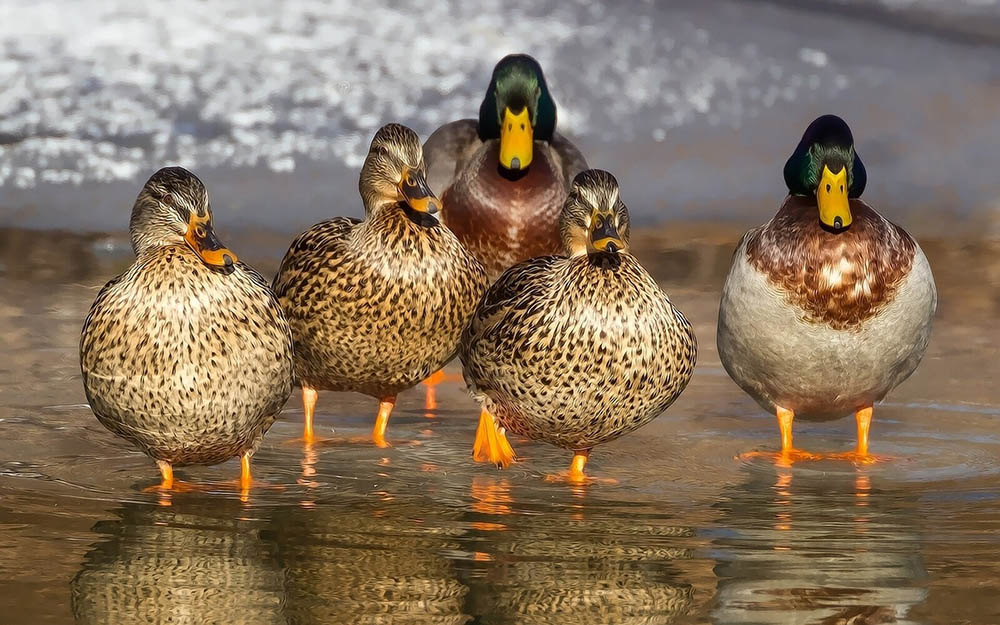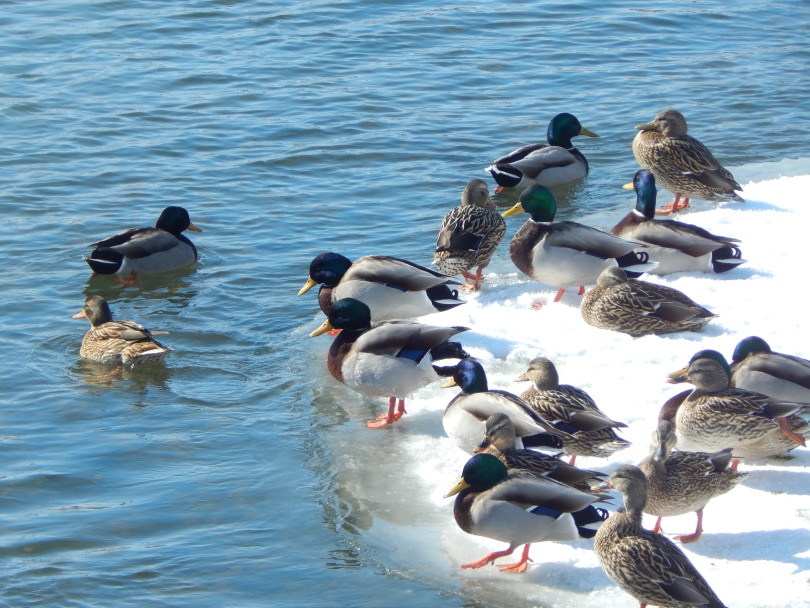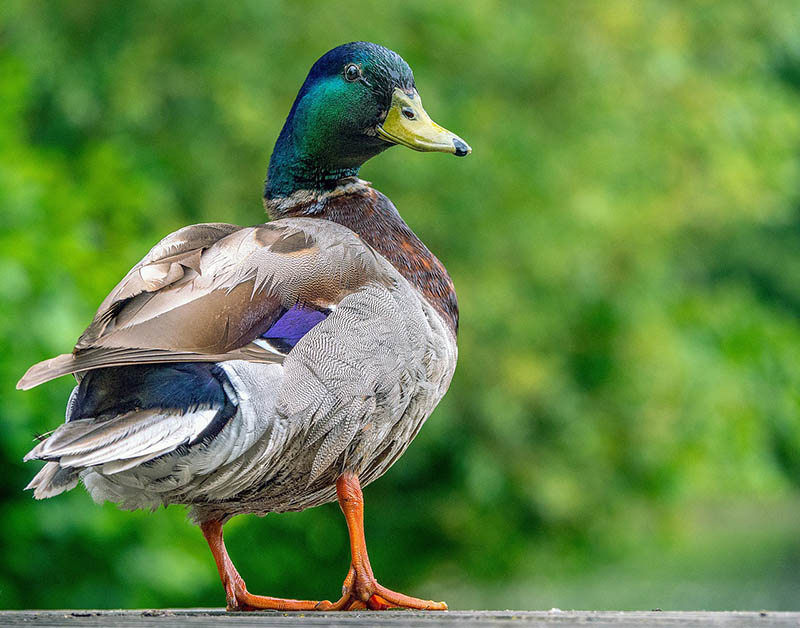Do Mallard Ducks Migrate? Everything You Need to Know
Last Updated on

Mallards are common bird species that mostly reside in or within a mile of water sources. These waterfowls often leave their aquatic habitats to find food in city parks and migrate southwards during winter. Like other birds, mallards are subjected to the effects of indiscriminate human activities like farming and construction in natural habitats.
Pollution and climate change are other major challenges threatening the existence of mallard ducks. The continued loss of prairie habitats like the grassy uplands has triggered their decline. Annual migration has helped these hardy waterfowls survive as they venture to find wetlands and more favorable temperatures.

Overview of Mallard Ducks
Mallard ducks or wild ducks are arguably the most populous birds in the world. Carl Linnaeus¹, a Swedish botanist and zoologist, is credited for giving these birds two binomial names in 1758: Anas platyrhynchos and Anas boschas. These birds are typically 20–26 inches long and weigh about 35–46 ounces.
The ducks are commonly found in subtropical Americas, North Africa, the Falkland Islands, and South Africa. The male mallard duck (drake) has purple patches on the wings, while the plumage of females has brown speckles. These ducks hang around ponds, streams, bays, marshland, or any aquatic habitat where they feed on plants, insects, snails, seeds, and fish.
The outer feathers are waterproof, and they shed the flight feathers twice per year, which grounds them until new feathers grow. Unlike many endangered bird species, mallard ducks are highly adaptable, so the International Union for Conservation of Nature¹ (IUCN) deems it a species of least concern.

The Pairing of Mallard Ducks
Pairing happens in the fall and winter, during which the drakes allure female mallards by dipping the beak in water, rearing it upwards, and then whistling and marking sharp calls. Once they find a female partner, the two mallards find a nesting site near a body of water.
Mallards are not particularly fussy when it comes to mating regions. They comfortably do so in vast geographical places, but mostly in the northern reaches of North America. Some of their favorite breeding locales are North Dakota, Saskatchewan, and Newfoundland.
Once they settle, the female mallard lays 7–10 eggs at a go and sometimes 5–15 eggs, then incubates them for 26–30 days. The female and new ducklings leave the nest within one day of hatching to find water. Ducklings are ready for the first flight within 60 days.
Migration Habits of Mallard Ducks
Mallards like warm weather, and this reflects in their migration patterns as they travel southwards during winter. The movement begins at the close of August and runs through December, with the heaviest traffic in October and November.
Nonetheless, not all mallards depart during winter. Some birds stay put in their chosen locales and subsist on whatever they find, such as food in community parks. Nevertheless, food insecurity and extremely cold temperatures can force them to move eventually.
Waterfowl that migrate usually relocate to the Middle East, Central America, or the southern parts of the United States. Apart from winter, mallard ducks migrate during spring for roughly 18–48 days. Then, they stop for about twelve days for rest and foraging before embarking on their chosen flyway. When tracking the mallard migration¹ using GPS, the Wetlands Reserve Program (WRP) surmised that some birds travel south to north during fall and winter.
Mallards are confident in water, land, and air and can travel long distances without stopping. For example, the waterfowls in North America can travel over 800 miles with freezing temperatures (below -15 degrees Celsius) at altitudes of 17,000 feet.
These ducks follow specific routes known as “flyways” toward their chosen destinations. Unfortunately, they often encounter challenges like urbanization, pollution, and the aftereffects of climate change. While their navigation capacity is unknown, scientists presume that mallards take cues from the sun, moon, and stars. The positioning of the solar system is key to following the proper flyway. These ducks also use geographical landmarks and magnetic fields to their advantage.

Banding research unearthed that mallard ducks traverse these flyways:
Atlantic Flyway
This flyway is the most densely populated and stretches for 3,000 miles from the Arctic tundra of Baffin Island to the Caribbean. The Atlantic flyway comprises places like Massachusetts, Vermont, Nova Scotia, and the territory of Nunavut. Rapid development and urban sprawl threaten the lives of mallards and other bird species.
Mississippi Flyway
This flyway is the most popular migration corridor and has the biggest waterway. The Mississippi flyway stretches for 2,300 miles and comprises places like Michigan, Indiana, Manitoba, and Ontario. Conservation efforts are afoot to protect the Great Lakes Watershed so mallards and other birds can safely traverse this route.
Central Flyway
This flyway spans more than 1 million square miles in Northern America. The Central route stretches from the boreal forest in Canada to the Great Plains and the Texas Gulf Coast. Jurisdictions covered by this flyway include Wyoming, New Mexico, and Alberta.

Pacific Flyway
This migration corridor spans 4,000 miles (north to south) and 1,000 miles (east to west). As a result, the Pacific flyway has the most varied collection of waterfowls, including places like California, Washington, and British Columbia.
Hundreds of birds follow the Midwest flyway (Mississippi flyway), which covers Indiana and is protected by the Conservation Law Center (CLC). This initiative is credited for implementing legal protections for mallards’ natural habitats, such as wetlands and marshes so that birds are safe during migration.
Safeguarding the migratory activities of birds is vital to preserving the equilibrium of the earth’s ecosystem. Notwithstanding their large population, mallards are susceptible to all manner of ills that affect other endangered species of birds.
Case in point, the kiwi of New Zealand only has five species left due to the shrinkage of natural forests. Uncontrolled developments and farming pursuits are encroaching on the natural habitats of kiwi, as per the International Union for Conservation of Nature (IUCN).

Final Thoughts
Mallard ducks are highly adaptable species of waterfowl. Their migration patterns southwards depict their preference for warmer climates when winter strikes. These birds migrate during the spring and winter, but not all waterfowls are on the move. Mallard ducks are not in acute danger of extinction, but they are still subjected to human-led harm targeting their natural habitats.
Featured Image Credit: 2554813, Pixabay
About the Author Robert Sparks
Robert’s obsession with all things optical started early in life, when his optician father would bring home prototypes for Robert to play with. Nowadays, Robert is dedicated to helping others find the right optics for their needs. His hobbies include astronomy, astrophysics, and model building. Originally from Newark, NJ, he resides in Santa Fe, New Mexico, where the nighttime skies are filled with glittering stars.
Related Articles:
10 Types of Hummingbirds in Arkansas (With Pictures)
8 Types of Hummingbirds in Nebraska (With Pictures)
5 Types of Hummingbirds in Idaho (With Pictures)
3 Types of Hummingbirds in Mississippi (With Pictures)
8 Types of Hummingbirds in Kansas (With Pictures)
5 Types of Hummingbirds in West Virginia (With Pictures)
5 Types of Hummingbirds in Ohio (With Pictures)
Where Do Nuthatches Nest? Nuthatch Nesting Habits Explained
